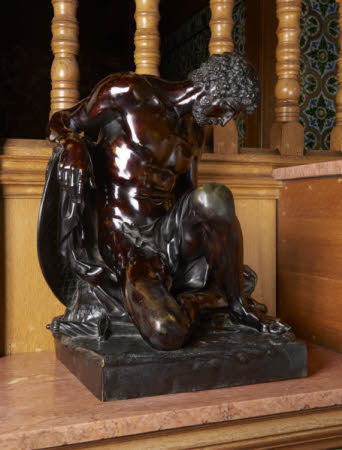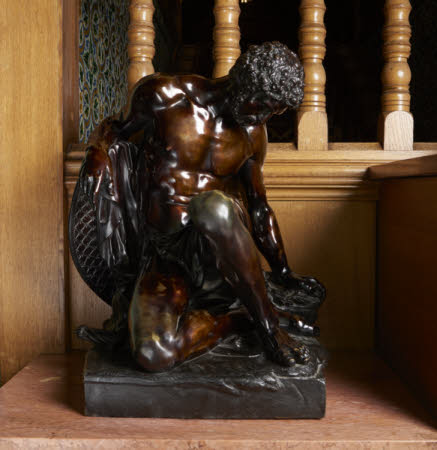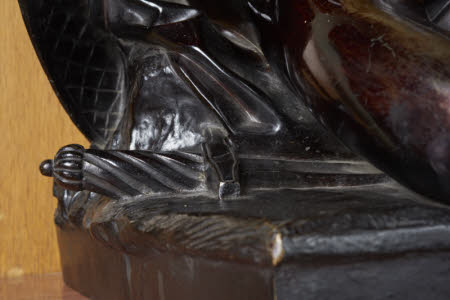The Dying Gladiator
after Pierre Julien (1731 - 1804)
Category
Art / Sculpture
Date
c. 1800 - 1820
Materials
Bronze
Measurements
610 mm (H)
Place of origin
Paris
Order this imageCollection
Cragside, Northumberland
NT 1228373
Summary
Bronze; The Dying Gladiator; after Pierre Julien (1731-1804); c. 1800-1820. A bronze figure of the Dying Gladiator, after a marble model presented by the artist as his reception piece for the French Academy in 1779. The part-naked figure is seated and looks down towards the ground
Full description
A bronze figure of the Dying Gladiator, with a young and bearded male figure seated upon the ground, naked except for a drapery across his midriff. Supporting himself upon his left hand, which clutches a laurel crown, and resting his right arm upon his circular bossed shield, partly covered by the swag of drapery, he looks down towards the ground and his laurel crown. His sword lies on the ground, beneath his right leg. The gladiator’s pensive expression, as his life ebbs slowly away, captures his mingling sensations of triumph and regret, memories and their extinction. This is a very well-cast and beautiful bronze, with a rich golden patination. A bronze cast after a once celebrated marble model by the French eighteenth-century sculptor Pierre Julien (1731-1804). Born in Le Puy, after training with a local sculptor Julien went to Paris, where he joined the workshop of Guillaume II Coustou. In 1768 he won a scholarship to the Académie de France in Rome, where he spent three years, before returning to Paris and work for Coustou. It was only after Coustou’s death in 1777 that Julien began to develop his own fully independent artistic personality. As a sculptor he adapted his style from a rococo idiom early in his career towards an ever-purer neo-classicism, in tune with the tastes of the years leading up to and into the French Revolution. The marble Dying Gladiator, proudly signed on the base ‘PAR Mr. JULIEN. 1779’, now in the Musée du Louvre, Paris (Pascal, Pierre Julien, pp. 26-28 ; Grandjean and Scherf, Pierre Julien 1731-1804, p. 32-35, no. 3), has always been recognised as one of his masterpieces, and ‘lies at the root of his reputation as one of the first to set France back on the true and narrow path of classicism.’ (West, From Pigalle to Préault, p. 89). It is a classic example of a composition based on an anatomical study of a male nude known as an académie, because drawing classes using hired models were regularly held at the Académie. The Dying Gladiator was Julien’s reception piece when, after a first rejection in 1776, he was elected to membership of the Académie Royale in 1779. A plaster version made in 1778 is in the Musée Denon, Chalon-sur-Saône (Pierre Julien 1731-1804, no. 4). The original inspiration for the subject of the Dying Gladiator came from the Roman marble in the Capitoline Museums in Rome, also sometimes known as the Dying Gladiator or, more usually, the Dying Gaul. In the eighteenth and nineteenth centuries, this was one of the most famous of antique sculptures (Francis Haskell and Nicholas Penny, Taste and the Antique. The Lure of Classical Sculpture 1500-1900, New Haven/London 1981, pp. pp. 224-27, no. 44), and was widely diffused through small bronze copies, examples of which are in National Trust collections (e.g. Belton House, NT 435473; Gunby Hall, NT 637918). The Capitoline marble is a more horizontal composition, with the dying man half-lying on the ground, and its subject is clearly a dying warrior, rather than a gladiator. Julien studied the sculpture when he was in Rome and indeed whilst there made a reduced copy of it for a French patron (Musée du Louvre, Paris; Pierre Julien 1731-1804, pp. 92-94, no. 1). For his own composition, Julien created however a more upright composition. For example, the shield lies on the ground in the Dying Gaul but here stands up vertically; Julien also added the laurel wreath, to emphasise that the man had been fatally wounded in a contest. The composition is remarkable for its boldness and for the coiled tension it contains within itself, with the weary lassitude of the right arm, resting upon the edge of the shield, contrasting with the rigid left arm, the only thing that prevents the dying man from falling and finally expiring. Gladiators were slaves, captured people who were forced to fight to the death for the pleasure of the Roman audiences who flocked to see the gladiatorial contests. In eighteenth-century France, the figure of Spartacus was seen as a symbol of the individual’s struggle for freedom against tyranny. Spartacus was a Thracian-born gladiator who inspired and led an army of fellow escaped slaves in defiance of the Roman state over some two years from 73-71 BC, until his heroic final stand against overwhelming Roman forces in a battle near modern Senerchia in southern Italy. The philosopher and historian Montesquieu (1689-1755) wrote in his Pensées (1726-1754) in the context of his arguments against slavery that ‘La guerre de Spartacus estoit la plus legitime qui ait jamais esté entreprise’ (‘The war of Spartacus was the most most legitimate ever to have been undertaken’), whilst in similar vein Voltaire (1694-1778), in his Dictionnaire philosophique (1764) suggested that ‘Il faut avouer que, de toutes les guerres, celle de Spartacus est la plus juste, et peut-être la seule juste.’ (‘It must be admitted that, of all the wars that have happened, that of Spartacus is the most just and, perhaps, the only just one.’). The marble Dying Gladiator was exhibited at the Paris Salon in 1779, where it caused a sensation. As one commentator wrote, ‘Il est composé avec genie, et supérieurement rendu. Ce n’est pas du marbre ; c’est de la chair, c’est un malheureux qui expire, et dont on partage la douleur : en un mot cette figure est toute âme. On ne voit pas souvent des morceaux de réception de cette force.’ (‘It is a composition of genius, and executed to a very superior level. This is not marble, it is real flesh, it is the death throes of an unhappy person, whose grief we share; in a single word, this figure is all soul. It is not often that we see reception pieces with the force that is present here’. Jean-Baptiste Radet in Ah ! Ah ! Encore une critique du Salon ! Voyons ce qu’elle chante !, Paris 1779, p. 29). Amongst all the praise, there were a few critics, Baron Grimm spotting the composition’s origins in an academic study: ‘ce n’est ni un gladiateur ni un homme qui se meurt, c’est toute au plus une figure académique, à laquelle on a fait faire une contorsion pénible’ (‘it is neither a gladiator nor a man committing suicide, at best it is an academic figure caought up in painful contorsions’, Friedrich Melchior Grimm, Correspondance littéraire, 1877-82 edition, Vol. 12, p. 330). But overall the sculpture was greatly admired and would come to be seen as a key work in the artist’s career. After Julien’s death in 1804, his friend Joachim Le Breton wrote movingly that ‘Le morceau de reception de Julien réunit, au plus rare degré, la science de l’art à la grâce naturelle et à la perfection du ciseu… Il vit encore, mais le souffle qu’il aspire sera le dernier. La pose, l’arrangement ne ressemblent à aucune statue antique connue, et toute la figure a le caractère de l’antique. C’est la beauté virile d’un homme en parfaite santé, qui meurt d’un accident. Julien prit par cet ouvrage, et en entrant dans l’Académie.. la première place de nos statuaires…’(‘Julien’s reception piece combines to the most exceptional degree the knowledge of art with natural grace and the perfection of the chiselling… He is still living, but this breath will be his last. The pose and the composition bear no relationship to any known antique statue, and yet the figure has all the character of the antique. Here is the virile beauty of a man in the peak of health who yet, by an accident, is now approached by death. With this work and his entry into the Academy, Julien took the first place among our sculptors…’ Joachim Le Breton, ‘Notice historique sur la vie et les ouvrages de Pierre Julien, Statuaire, de l’ancienne Académie royale de peinture et de sculpture’ [1805] in 'Revue Universelle des Arts', 13 (1863), pp. 175-88, p. 181). The bronze version of the model would certainly have been made in Paris and the first casts were probably produced around 1800 or into the early decades of the nineteenth century, so possibly even in Julien’s lifetime. A version in bronze was sold as early as 1813 in Paris (Catalogue d’une Collection de Tableaux…. [M. Irlande and M. Bordier], Lebrun, Paris, 27 January 1813, lot 104). It was part of a collection of bronzes, the introduction to the catalogue for which implied that all the casts had been made recently and with the greatest care in their casting and their finishing (‘..La fonte en a été soignée, et cette perfection conserve les beautés réelles; leur monture est aussi soignée et la ciselure y est menagée avec ce respect qu’il appartient d’avoir pour les chefs-d’oeuvre..’ – ‘the casting has been very carefully done, to a perfection that preserves the true beauty of the originals; they have also been carefully mounted and the chasing has been carried out with that respect that is fitting for masterpieces…’). This statement is significant in the context of the Cragside version of the Dying Gladiator, which is an exceptionally finely executed bronze. A number of casts in bronze are known. As well as the Cragside version, examples are in Bury Art Museum (Inv. BUYGM.0684.1959) and the Speed Art Museum, Louisville, Kentucky (Inv. 1971.9), whilst one was sold in London in 1992 (Sotheby’s, 20 March 1992, lot 91) and another in Paris in 2011 (Sotheby’s, Important French Furniture, Sculpture and Works of Art, 30 September 2011, lot 187). The casts appear from photographs to be very similar, so it is likely that they depend directly or indirectly from the same master model. The Cragside figure has an unusual patch of abrasion of the surface on the left knee. This results from an Armstrong family tradition, on ascending or descending the staircase on which the bronze is situated, to touch the knee for good luck. Jeremy Warren March 2022
Provenance
Armstrong collection. Transferred by the Treasury to The National Trust in 1977 via the National Land Fund, aided by 3rd Baron Armstrong of Bamburgh and Cragside (1919 - 1987).
Makers and roles
after Pierre Julien (1731 - 1804), sculptor
References
Pascal 1904: André Pascal, Pierre Julien, Sculpteur (1731-1804). Sa Vie et son Œuvre, Paris 1904, pp. 26-28. West 1998: Alison West, From Pigalle to Préault. Neoclassicism and the Sublime in French Sculpture, 1760-1840, Cambridge 1998, pp. 89-90, fig. 119. Worley 2003: Michael Preston Worley, Pierre Julien. Sculptor to Queen Marie-Antoinette, New York 2003, pp. 37-41, figs. 3-5. Grandjean and Scherf 2004: Gilles Grandjean and Guilhem Scherf, Pierre Julien 1731-1804, exh.cat., Musée Crozatier, Le Puy-en-Velay 2004, p. 32-35, no. 3.




